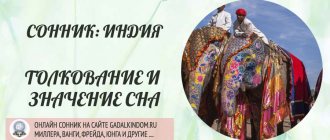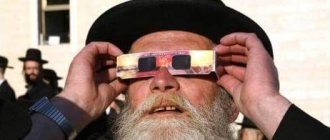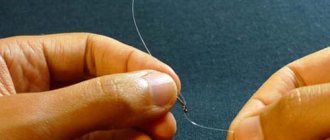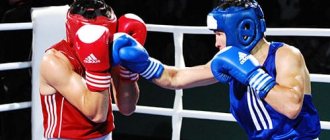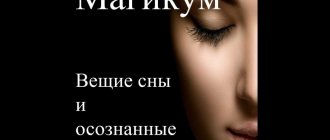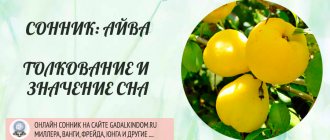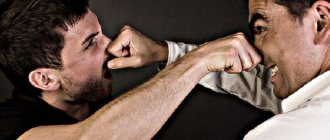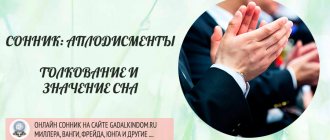Seeing a rider on a horse or riding a horse in a dream means quickly achieving your goal. Good news means a knight on a white horse. If you dreamed that he was on a dark horse, get ready for troubled times in your life. When telling why you dream about horse riding, dream books recommend remembering your role in the dream.
Miller's dream book warnings
Psychologists reduce the interpretation of dreams to communication, the dreamer’s ability to find a common language with others. Racing on horseback means overcoming obstacles and solving problems using non-standard methods. It’s great if you dreamed of many cavalrymen at the same time.
When describing why riders on horses dream of, the dream books of psychologists pay attention to additional information:
- armed guard - to work on a major project;
- headless rider - good news;
- trumpeters - to receive a valuable gift;
- knights during a duel - several fans are trying to win your heart at once;
What does it portend?
Riding an eagle or other bird means a creative takeoff, the ability to create something significant. Riding on horseback, escaping from pursuit - achieving success in a difficult task.
Falling off a horse is an extremely bad sign, foreshadowing failure, collapse of hopes, complete fiasco in your endeavors. Seeing a headless horseman in a dream means receiving stunning news. Another interpretation of this image is a hasty marriage that will not be successful.
Riding together on one horse means marriage for love. Sometimes, however, this dream means betrayal of a loved one or hidden jealousy.
The horseman is a very bright and significant symbol, despite the fact that in real modern life only rare equestrian lovers ride horses. However, in a dream, archetypal symbols retain their significance, regardless of existing realities. “Being on a horse” still means success, strength and ability to control the situation.
Even if you dream of an ominous black rider on a black horse with burning eyes, you should not be afraid. Perhaps the reason for such a dream was a mystical horror film watched the day before or an excessive passion for books and computer games in the fantasy style.
Don't give in to temptation
Seeing a rider on a horse, but not being able to get closer to him, means the collapse of a love relationship. A family dream book predicts a partner’s betrayal if you dreamed that you were galloping after someone through the desert in exhaustion, but the fugitive’s horse was inexorably moving away. Being a rider yourself in a dream means actively pursuing a traitor in reality.
Envy will overwhelm everyone who happened to see a beautiful lady riding a thoroughbred horse in a dream. It turns out that your partners are much more successful in business and in their personal lives. Try to pull yourself together and start working on your shortcomings in order to not only compare with your rivals, but also surpass them.
An idol with an outstretched hand on a loudly galloping horse
Inga Slazhinskaite, May 16, 2021, 21:35 — REGNUM
Horseman of the Russian Empire
Ilshat Mukhametyanov © REGNUM news agency
The Bronze Horseman is the undisputed and most recognizable symbol of St. Petersburg. This is the first thing tourists who come to the city rush to post on social networks. Not a single wedding photo shoot of the townspeople themselves is complete without it. There are also those who regularly try to ride the bronze horse of Peter the Great. However, the monument no longer suffers from vandals, but from the humid St. Petersburg climate. To ensure that the main monument of the city does not lose its shine, it is traditionally washed by experienced restorers on St. Petersburg’s birthday.
Bronze Horseman (fragment of the monument)
(cc) Andrew Butko
The idea of the empress and the French plan
“To erect a monument to the blessed memory of Emperor Peter the Great,” Catherine II orally ordered on May 15, 1768. So more than a century ago the historian and journalist Mikhail Pylyaev wrote, telling about the creation of the Bronze Horseman.
Since the poem by Alexander Sergeevich Pushkin, the main character of which was the monument to Peter I, was published in the century before last, this name has forever been assigned to the monument, under which it is now known throughout the world.
Alexander Benois. Illustration for A.S. Pushkin’s poem “The Bronze Horseman”
The monument is located in the very heart of St. Petersburg - on Senate Square, next to the Admiralty founded by the Emperor and the building of the Senate - the main legislative body of Imperial Russia. The sovereign's gaze is fixed on the Neva, and behind him already in the 19th century the majestic St. Isaac's Cathedral appeared. It was on the site of the monument that in 1710 stood the very first wooden St. Isaac's Church, which was ordered to be built by Peter I himself, who was born on the day of remembrance of the early Christian saint Isaac of Dalmatia.
The Bronze Horseman against the backdrop of St. Isaac's Cathedral. 19th century color photolithography (1890–1900)
The opening of the monument to Peter I took place in 1782. At the same time, the history of the creation of the Bronze Horseman is almost as interesting as the biography of the emperor himself. So, for example, the sculptor for the monument to Empress Catherine II was recommended by her French friend, the philosopher-educator Denis Diderot - Catherine invited Etienne Falconet to the capital of the Russian state, who came to St. Petersburg together with a young student Marie-Anne Colot. Later, it was she who made the head of Peter for the monument: the empress rejected the sketches proposed by Falcone.
By the way, the sculptor had to show great stubbornness in order to embody exactly his idea in the monument, since the crowned and noble persons did not give Falcone peace regarding the image of both Peter the Great and the monument as a whole. So, Catherine II wanted to see the emperor in the guise of the Roman Caesar, on horseback and with a staff or scepter. Ivan Betskoy, the empress’s secretary, who supervised the construction of the monument, imagined him in the image of a commander, a full-length figure with a staff in his hand. Even Diderot managed to propose the option of constructing a fountain framed by allegorical figures.
“My king does not hold any rod, he extends his beneficent right hand over the country he travels around. He climbs to the top of the rock, which serves as his pedestal - this is an emblem of the difficulties he has conquered,” Falcone wrote with conviction about his plan.
Bronze Horseman, 19th century. Photo - Ivan Bianchi
Falcone worked on a life-size model of the monument on the site of the former temporary Winter Palace of Elizabeth Petrovna. As Mikhail Pylyaev wrote, at that time passers-by could watch here how, for several hours a day, a guards officer took off on a horse onto a wooden platform and reared it, and Falcone sat at the window and carefully sketched what he saw. The horses for work on the monument were taken from the stables of Count Alexei Orlov: the horses Brilliant and Caprice.
"Thunder-stone" for Peter the Great
After the model of the monument was cast, Catherine II ordered to find the appropriate stone for the base, for which a corresponding appeal was published in the newspaper St. Petersburg Vedomosti. As a result, the base of the monument was a huge granite block weighing more than 1800 tons, found by the peasant Semyon Vishnyakov in the swampy lands of the Lakhtinsky forests. The granite rock, broken by a lightning strike, was popularly called “Thunder-stone” and “Horse-stone”. The block went more than 4 meters into the ground and was all covered with moss. “Looking at her aroused surprise, and the thought of transferring him to another place brought horror,” wrote one of his contemporaries.
Peddlers at the Bronze Horseman. Photo - Karl Bulla. 1913
And indeed, the delivery of the “Thunder Stone” to St. Petersburg took more than a year and a half. The path to the loading site was approximately 8 versts, that is, approximately 8.5 kilometers. After the stone was removed from the ground, the pit was filled with water, and a reservoir was formed that has survived to this day - Petrovsky Pond. During transportation, the monolith was gradually hewn and, ultimately, given the shape of a sea wave to emphasize the emperor's desire to assert the strength of Russia as a great maritime power.
On November 20, 1770, Catherine visited the work of transporting stone, and many St. Petersburg residents came to watch this action. In memory of this extraordinary transport operation, a medal was minted with the inscription “Like daring. January 20, 1770.” The rock arrived at Senate Square on September 23, 1770. “The Russian Mountain, not made by hands here, Hearing the voice of God from the lips of Catherine, Came to the city of Petrov through the Neva abyss. And she fell under the feet of the Great Peter,” wrote the poet Vasily Rubin that same year.
The difficult birth of a masterpiece
Preparing a life-size plaster model of the monument took twelve years. It was with difficulty that they found a foundry worker willing to take on the casting of the statue. It turned out to be cannon master Emelyan Khailov. Casting of the Bronze Horseman began in 1774. But the work ahead was not easy: in order to give the monument stability, the thickness of the front walls of the sculpture had to be less than the thickness of the rear ones.
“PETER THE FIRST KATHERINE, second summer 1782.” — inscription on the right side of the granite pedestal of the Bronze Horseman
Yulia Karnaeva © REGNUM news agency
During the first pour, the mold cracked and molten bronze flowed onto the floor. Falconet ran out of the workshop in horror, the workers ran after him, and only the foundry worker Khailov remained in place, he actually saved the statue. Later, the errors caused by unsuccessful casting were corrected by polishing. The final filling took place in November 1777. On one of the folds of Peter I’s cloak, the sculptor left the inscription “Modeled and cast by Etienne Falconet, a Parisian in 1778,” but not a word about Khailov.
Ultimately, Falcone managed to realize his grandiose idea, but a series of court intrigues and threats from envious people forced him to leave the city before the grand opening of the monument. The installation of the “Bronze Horseman” on the pedestal after the departure of the author of the monument was supervised by the architect Fyodor Gordeev, who sculpted a snake under the horse’s foot. Falcone was never invited to the opening of his Russian brainchild.
Plaque on the Bronze Horseman monument
Yulia Karnaeva © REGNUM news agency
At the grand opening of the monument on August 7, 1782, Catherine the Second herself was present. She ordered to inscribe on the pedestal: “PETER the first KATHERINE second summer 1782.” on the one hand, and “PETRO primo CATHARINA secunda MDCCLXXXII.” - on the other hand, thereby emphasizing the line of continuity between the actions of Peter and his own activities.
Actors playing the roles of Catherine II and Peter I against the backdrop of the Bronze Horseman monument
Yulia Karnaeva © REGNUM news agency
Secrets of the monument
Time has proven the empress’s choice to be correct - to this day, the Bronze Horseman is rightfully considered one of the best equestrian statues in the world, the main symbol of St. Petersburg and the pinnacle of Falcone’s creativity. And modern studies of the monument have even led to sensations. Firstly, the sculpture does not rest on three support points, as was always previously thought, but on two - the snake and the horse’s tail do not bear the load. And secondly, Peter’s pupils are made... in the shape of hearts - Peter the Great looks at the city he founded with loving eyes.
Monument to Peter I by Etienne Falconet
Yulia Karnaeva © REGNUM news agency
Naturally, the 18th-century monument needs systematic careful care. During the first restoration in 1909, many deep fistulas and cracks were discovered in the bronze. Through these cracks, precipitation penetrated inside the monument and destroyed its frame. When the hatch on the horse's rump was opened, it turned out that up to 150 buckets of water had accumulated inside the statue. It was decided to drill holes for water drainage - they were made in the rider’s heels, in the horse’s front hooves and belly.
Systematic monitoring of the condition of the Bronze Horseman began only during the years of Soviet power. This work is still carried out by the State Museum of Urban Sculpture of St. Petersburg.
“PETRO primo CATHARINA secunda MDCCLXXXII” - the inscription on the left side of the granite pedestal of the Bronze Horseman
Yulia Karnaeva © REGNUM news agency
After cracks were discovered on the horse's hind legs, which served as the main support of the monument, another restoration was carried out in 1976. To understand the condition of the iron rods inserted into the horse’s hind legs, experts illuminated the monument with gamma rays for three nights. It turned out that the cracks in the hind legs were casting defects and increased due to the effects of temperature fluctuations and precipitation. They were sealed to prevent further destruction.
A group of tourists near the Bronze Horseman
Yulia Karnaeva © REGNUM news agency
Vandals and humid climate
Today, the Bronze Horseman is a favorite place for meetings and photo sessions for city residents. Not a single wedding is complete without a visit to this historical place: the newlyweds traditionally lay flowers to the founder of the city and drink a glass of champagne.
Traditional wedding visit of the city founder
Yulia Karnaeva © REGNUM news agency
The endless attempts of citizens and guests of the city to saddle the emperor’s horse have become a bad tradition. This usually happens on days of mass public festivities. This happened on Victory Day on May 9, 2016 - an unknown person climbed onto the Bronze Horseman with a Russian flag in his hands. Photos of this act immediately appeared on social networks. During the discussion, the majority of St. Petersburg residents were outraged by the behavior of the hooligan: the man stood with one foot on a horse, and the other on the face of Peter I. People agreed that in this way the holiday was desecrated and disrespect for the cultural values of the city was shown. Fortunately, the monument was not damaged. Nothing was reported about the arrest of the hooligan - he probably escaped safely after his outrageous prank.
Meanwhile, the Bronze Horseman, like other monuments of the northern capital, suffers not only from the actions of people, but also from the St. Petersburg climate. “We have a very humid climate and mobile soils. The city stands on a swamp, and the process of water suction continues all the time,” the current city restorers REGNUM
Favorite place for meetings and photo shoots of citizens
Yulia Karnaeva © REGNUM news agency
Usually, the main symbol of St. Petersburg is washed, and at the same time a preventive inspection is carried out, on the eve of City Day, which is celebrated on May 27. “Wash with a weak alkaline solution and high-pressure water. We call two towers and use a special apparatus to direct a stream of water. This is a preventive flushing to wash away dirt and heavy metals from the monument, which settle in large quantities from the roadway over the course of a year. If necessary, a decision is made on hydrophobization—coating with bleached wax,” explained Georgy Balakhnichev, head of the service for the care and maintenance of monuments at the Museum of Urban Sculpture.
Bronze Horseman
Yulia Karnaeva © REGNUM news agency
This year, the Bronze Horseman will be polished to a shine on Thursday, May 19th.
See the full photo report by Yulia Karnaeva
Great news ahead
Stunning news, dizzying success with the opposite sex - this is what a trumpeter on a white horse dreams of. The dream book of Nostradamus guarantees a quick completion of business and the beginning of a period of vacations and time off. The seer believes that news from afar will definitely be bright and joyful.
If a rider on a horse turns out to be headless in a dream, do not rush to be upset. The dream means that you will have access to stunning information about your opponents, which will allow you to get ahead of them and beat them.
The chosen one is already nearby
To find out why knights in armor taking part in tournaments dream, Tsvetkov’s dream book advises remembering your own mood in a dream. If you were sitting in the stands, watching the fights, or rooting for one of the participants, get ready for heated declarations of love.
For an unmarried girl to see a rider on a horse - to a prosperous marriage. If you dreamed that it was a man you knew, it means that it was he who would propose marriage. If the rider was a father or brother, be prepared that they will bring into the house a man who will later become your husband.
Other details
Also pay attention to what the dreaming horseman was wearing. Shiny golden armor indicates that you are receiving very valuable help that you are not even expecting. Most likely, you will not even be able to understand where it came from and who exactly helped you. It will seem to you that the Lord himself intervened and did everything possible to avert trouble from you.
Have you ever seen yourself with someone on a horse? I dreamed about this image as a herald of an upcoming wedding, a happy marriage and true love from a loved one. Women who watch themselves galloping on horses will become happy, and the basis for this will be high spirituality.
We recommend: Why do you dream about a sword?
If a woman saw a rider rushing towards her on a white horse, most likely she still dreams of a prince, an ideal man. In this case, the dream book advises looking at things more realistically and not clinging to the small shortcomings of your partner. If you saw the features of your beloved in this knight, it means that you are often jealous of him, and you do it in vain, he is faithful to you.
What does the horseman of the apocalypse bring with him in dreams? Many may be immediately frightened, believing that he brings death. But this is far from true - this image symbolizes very important information that will be received in the near future. Whether it will be positive or negative can be determined by the faces of the knights and the color of the horses. But there will definitely be nothing terrible in such news.
When a galloping horse leaves behind huge clouds of dust, you will soon take on additional responsibilities. Perhaps you will be promoted or find additional income.
Let's look at the dream book again; the rider can be not only male, but also female. If you saw yourself as a rider on an ugly horse, success in society, respect from others and respect from colleagues await you. The main thing is not to spoil it with your character; restrain your emotions in any situation.

